 |
 |
 |
| |
Lifestyle factors and population attributable risk of hepatocellular carcinoma in lean vs non-lean populations - More Coffee Tied to Lower Liver Cancer Risk in US Group
|
| |
| |
EASL International Liver Congress 2022, London, June 22-26, 2022
Mark Mascolini
Drinking 2 or more cups of coffee daily cut risk of hepatocellular carcinoma (HCC) 30% in an ethnically diverse 181,346-person US cohort [1]. In lean people, downing more than 2 cups of java daily halved HCC risk. This study of a California-Hawaii cohort also found that obesity boosted HCC risk by two thirds, while smoking tripled the risk. 66% of HCC cases might have been prevented by removing these 6 risk factors in lean people & 37% in non-lean.
Researchers from the University of Southern California (USC) and the University of Hawaii noted that HCC ranks third in causes of cancer death. As incidence of alcohol- and nonalcohol-related liver disease rises, they said, identifying and modifying HCC risk factors gains urgency. Observational studies tie several modifiable risk factors to HCC development: smoking, alcohol, physical activity, diet quality, coffee, and obesity.
The USC/Hawaii investigators planned this study to figure individual and combined population-attributable risk (PAR) for modifiable lifestyle HCC risk factors. PARs represent the proportion of HCC cases that removing a risk factor may prevent in a population [2]. They also aimed to compare PAR in lean people (normal body mass index) versus nonlean people (elevated body mass index) because lifestyle factors can differ between those two groups.
This prospective analysis involved people in the Multiethnic Cohort Study, which includes more than 215,000 men and women 45 to 75 years old in California and Hawaii. With cohort entry in 1993-1996, follow-up now extends over 20 years. When people entered the Multiethnic Cohort Study they completed a 26-page questionnaire that included quantitative diet history (aMED adherence score). Researchers linked cohort members to statewide California and Hawaii cancer registries through December 2017. They identified incident (newly diagnosed) HCC by histology code C22.0 and morphology codes 8170-8175.
A multivariable Cox model adjusted for age, sex, race/ethnicity, diabetes, and hypertension explored associations between each lifestyle factor and HCC for the whole population and for lean and nonlean participants. For non-Asians lean meant a body mass index below 25 kg/m2; and for Asians lean meant a body mass index below 23.5 kg/m2. The USC/Hawaii team based PAR comparisons on the following dichotomies for each risk factor: smoking (current vs former or never), alcohol use (heavy vs moderate or none), physical activity (none vs low to high), diet quality (lowest [worst] quintile vs quintiles 2 to 5), coffee intake (0 or 1 vs 2 or more cups daily), obesity (yes vs no).
The study population included 63,369 lean people (35%) and 117,977 nonlean people (65%). Overall age averaged 60 years, 46% of the cohort were men, 16% black, 29% Asian, 22% Hispanic, 25% white, and 7% Native Hawaiian.
While HCC developed in 169 lean people (0.3%), HCC got diagnosed in 684 nonlean people (0.6%). Certain risk factors proved more prevalent in people diagnosed with HCC than in those who remained HCC-free: former or current smoker 72.9% vs 56.1%; heavy alcohol use 23.1% vs 14.8%; fewer than 2 cups of coffee daily 79.7% vs 75.6%; suboptimal diet quality 82.8% vs 78.1%.
Multivariable analysis identified six factors independently associated with newly diagnosed HCC in the overall population and/or in the lean or nonlean population at the following hazard ratios (HR) (and 95% confidence intervals):
Former smoker vs never: overall HR 1.64 (1.37 to 1.96); lean HR 2.08 (1.40 to 3.09); nonlean HR 1.55 (1.26 to 1.89)
Current smoker vs never: overall HR 2.96 (2.40 to 3.67); lean HR 4.41 (2.86 to 6.81); nonlean HR 2.62 (2.04 to 3.35)
Heavy alcohol vs none: overall HR 1.24 (1.02 to 1.51)
Diet quality quintile 5 (best) vs quintile 1 (worst): overall HR 0.69 (0.54 to 0.88); nonlean HR 0.61 (0.46 to 0.80)
2 or more cups of coffee daily vs none: overall HR 0.70 (0.57 to 0.87); lean HR 0.47 (0.29 to 0.77); nonlean HR 0.77 (0.50 to 0.98)
Obesity yes vs no: overall HR 1.65 (1.41 to 1.94)
PAR (proportion of HCC cases that would not develop if the risk factor disappeared) proved highest for low coffee intake (21.3%), followed by smoking (15.1%), obesity (14.5%), alcohol use (7.1%), physical activity (5.5%), and diet quality (4.1%). Eliminating ALL these risk factors would prevent more than half of new HCC diagnoses in this population (51.9%).
Eliminating abstaining from coffee had a much greater impact on PAR in lean people than nonlean people (45.1% vs 14.8%). The same imbalance held true for eliminating smoking (PAR 24.9% in lean and 12.3% in nonlean). Avoiding all analyzed risk factors also had a greater impact in lean people than in nonlean people (PAR 65.2% vs 37.4%).
The researchers cautioned that their findings in this ethnically diverse California-Hawaii group may not apply to other populations. Also, their analysis lacked data on one critical HCC risk factor, viral hepatitis.
With those limitations in mind, the USC/Hawaii team concluded that more than half of new HCC cases in this population might be prevented by avoiding all the lifestyle risk factors analyzed. The HCC-prevention benefit of drinking 2 or more cups of coffee daily proved particularly striking, especially in lean people. The researchers stressed that the contribution of modifiable risk factors to HCC risk was greater for lean people (those with normal body mass index) than for nonlean (overweight and obese) people.
References
1. Zhou K, Lim T, Dodge JL, et al. Lifestyle factors and population attributable risk of hepatocellular carcinoma in lean vs non-lean populations. EASL International Liver Congress 2022, London, June 22-26, 2022. Abstract OS106.
2. Encyclopedia of Public Health. Population Attributable Risk (PAR). https://link.springer.com/referenceworkentry/10.1007/978-1-4020-5614-7_2685
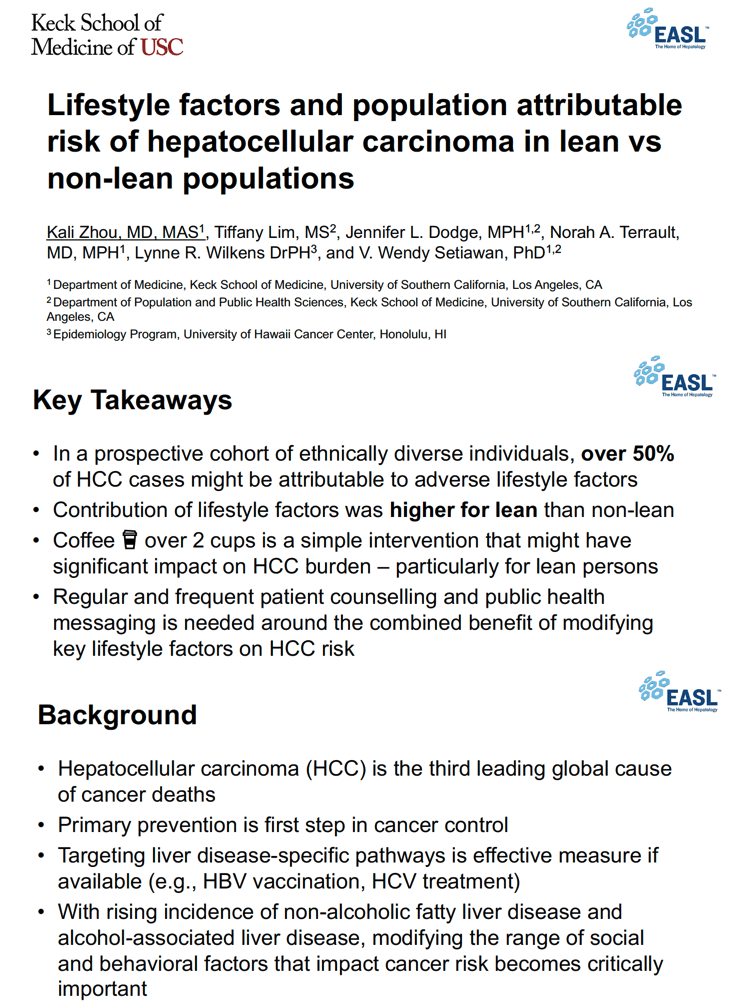
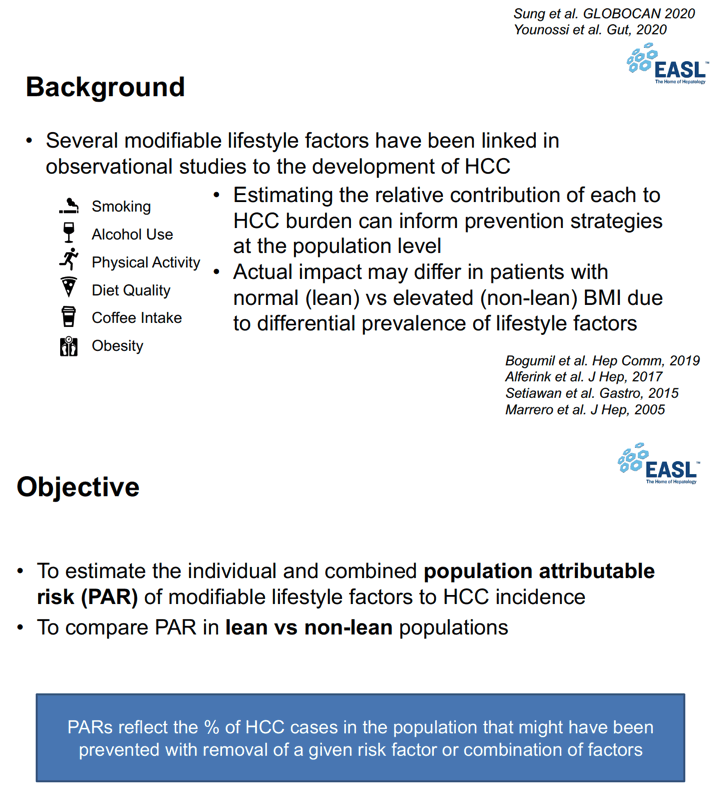
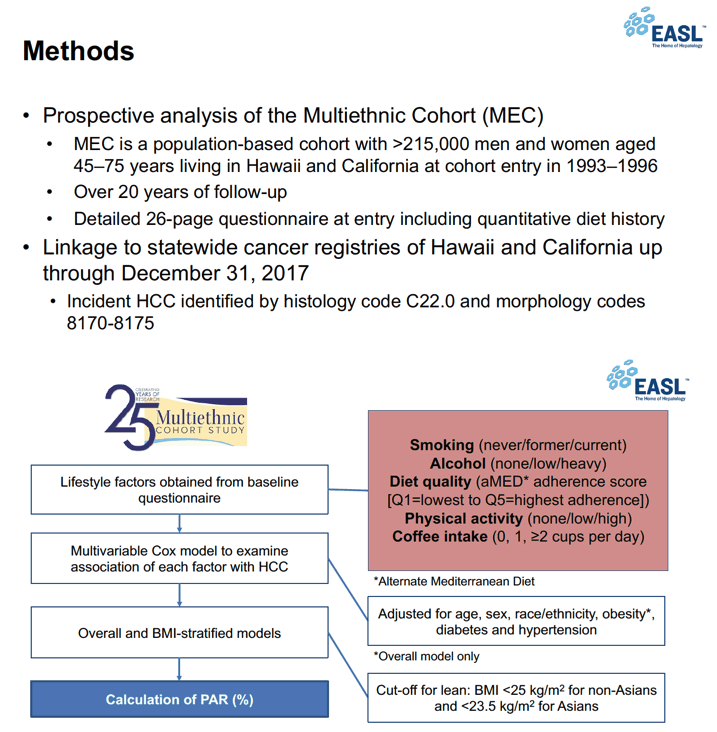
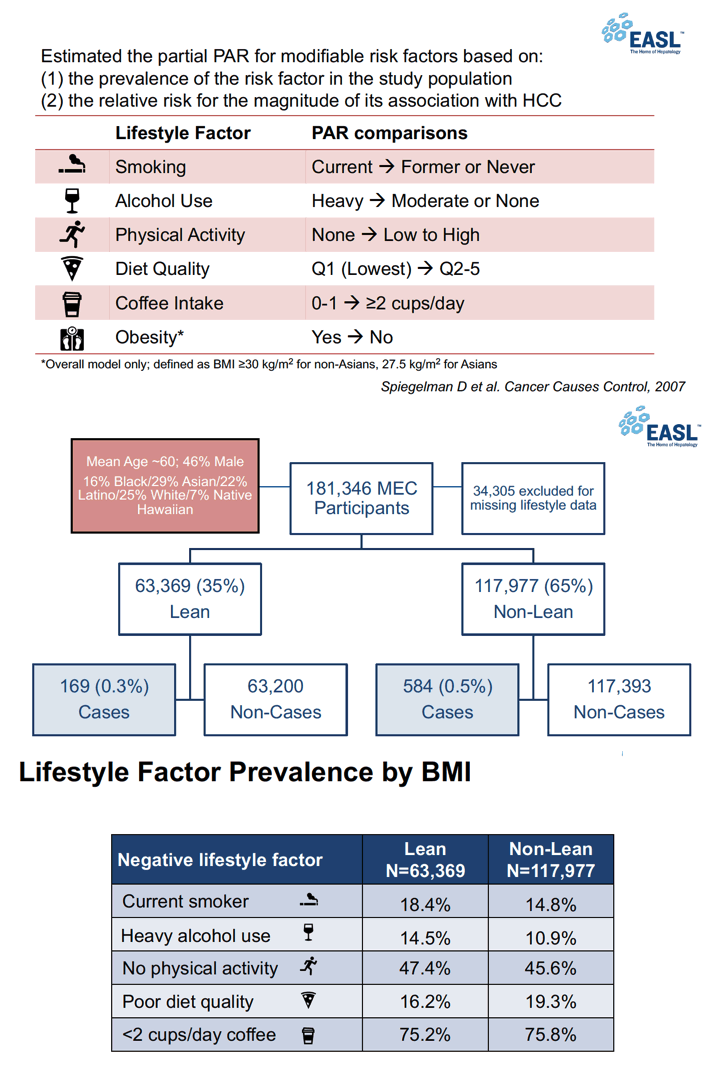
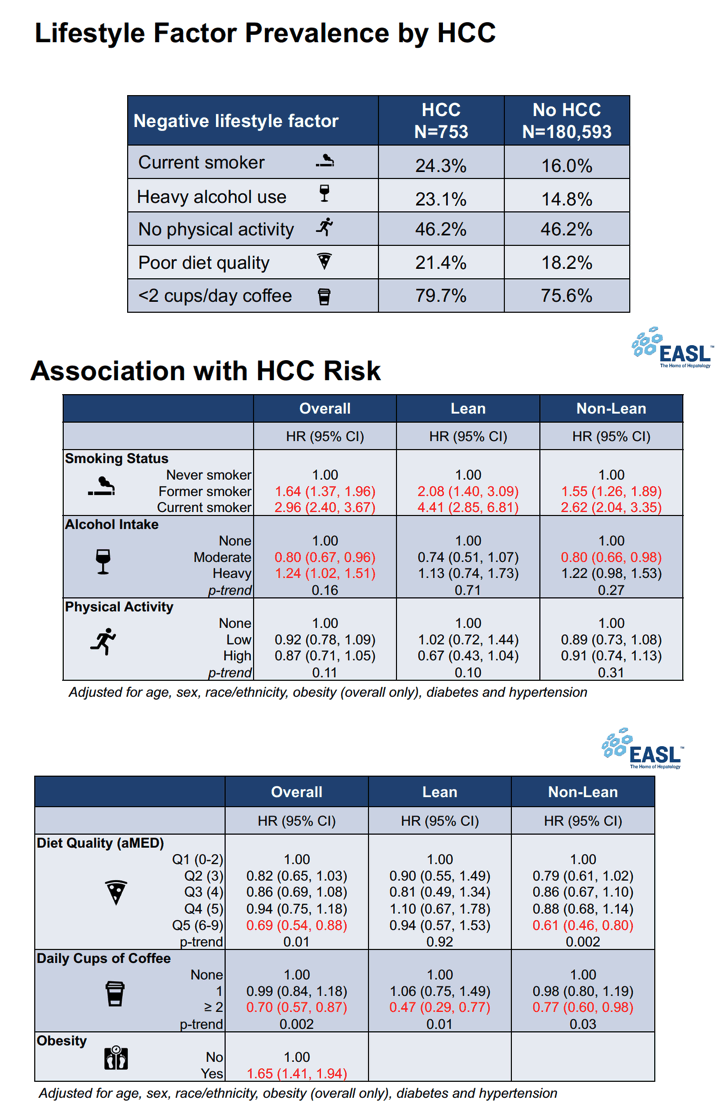
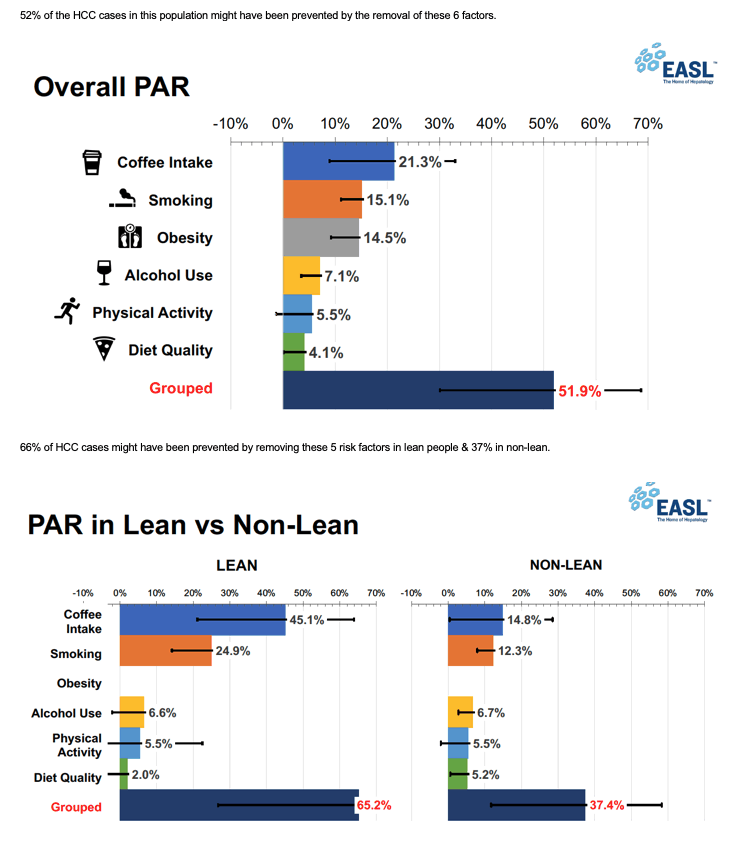
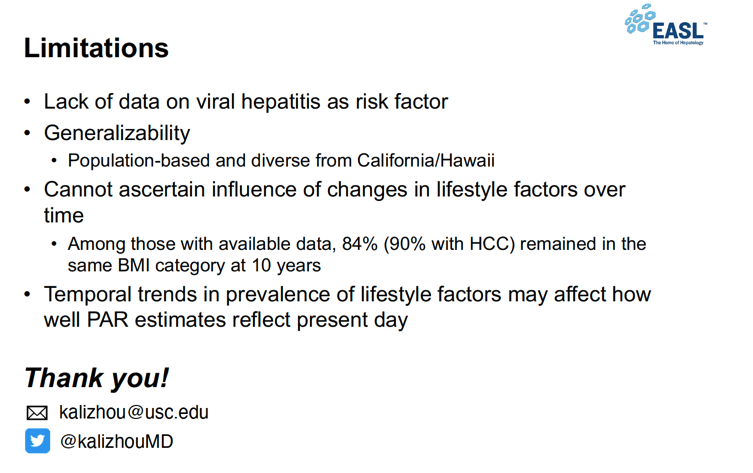
|
| |
|
 |
 |
|
|